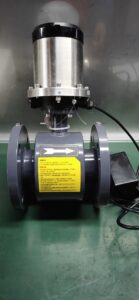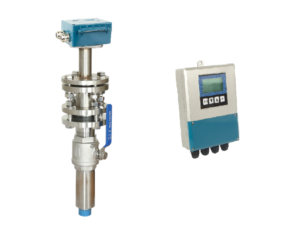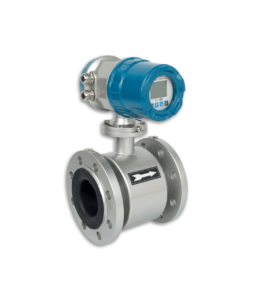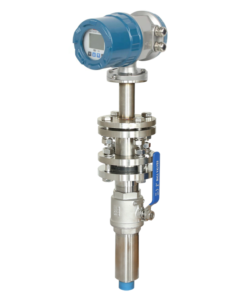The main content and methods of the electromagnetic flowmeter verification are shown in the table.
| Test content | Detection method | Test purpose |
| Metering performance |
Volumetric method | Verification, standard, factory inspection |
| Weighing method | ||
| Standard meter method | ||
| Variable headwater tower method | Standard, factory inspection |
|
| Other properties | – | Type evaluation, product quality inspection |
| Flowmeter working status |
Online check | Check the working status of the flowmeter online |
| Flowmeter comparison method |
Flowmeter measurement performance testing
The measurement performance requirements for electromagnetic flowmeters mainly include two technical indicators: error and repeatability of the flowmeter.
The common accuracy grades of electromagnetic flowmeters are shown in Table 4-5. The relative indication error (or reference error) of each accuracy grade flowmeter should meet the corresponding maximum allowable error within the specified flow range.
| Accuracy | 0.2 | 0.25 | 0.3 | 0.5 |
| Maximum allowable error | ±0.2% | ±0.25% | ±0.3% | ±0.5% |
| Accuracy | 1 | 1.5 | 2.5 | / |
| Maximum allowable error | ±1.0% | ±1.5% | ±2.5% | / |
The repeatability of the flowmeter shall not exceed 1/3 of the absolute value of the maximum allowable error specified by the corresponding accuracy level.
1. General test conditions for verification and calibration
(1) Flow standard device The flow standard device (hereinafter referred to as the device) and its supporting instruments should have a valid verification certificate, and the expanded uncertainty of the device’s measurement results should not be greater than 1/3 of the absolute value of the maximum allowable error of the flowmeter being inspected.
If the instantaneous flow rate of the tested meter is detected, the flow stability of the device should meet the following requirements: if the absolute value of the maximum allowable error is equal to or less than 0.5%, the flow stability of the device should be better than 0.2%; for the absolute value of the maximum allowable error greater than 0.5 % Of the flowmeter, the device flow stability should be better than 0.5%.
When the vapor pressure of the test liquid is higher than the atmospheric pressure, the device should be closed, the electrical equipment used for the test should be grounded, and the equipment used to collect the output signal of the tested meter during the test should match and be able to meet the test requirements.
(2) Test liquid The test liquid can generally be clean water that does not contain air, fibers, magnetically conductive particles, and other visible particles. If other liquids are used, the type (including commercial name) viscosity, density, and conductivity should be determined or determined after the test as needed. During the test, the liquid should always be filled with the test pipe, and it should be a single-phase stable flow without a vortex.
The pressure of the test liquid at any point in the piping system and the flow meter should be higher than its saturated vapor pressure. For test liquids that are easily vaporized, there should be a certain back pressure downstream of the flowmeter. The recommended back pressure is 1.25 times the saturated vapor pressure of the test liquid at the highest test temperature.
The conductivity of the test liquid should be 5mS/m (50uS/cm) to 500mS/m (5000S/cm), or separately determined according to the technical indicators given by the flowmeter manufacturer. The temperature range of the test liquid should be between 4℃ and 35℃. During each test at each flow point, the temperature of the liquid should not change more than ±0.5℃.
(3) Test environment conditions Atmospheric environmental conditions should generally meet: Ambient temperature: 5℃ ~35℃; Relative humidity: 15% ~ 85%;
Atmospheric pressure: 86kPa~ 106kPa. The AC power supply voltage should be (220±22)V, and the power supply frequency should be (50±2.5)Hz. A suitable AC or DC power supply (such as a 24V DC power supply) can also be used according to the requirements of the flowmeter.
The external magnetic field should be so small that the impact on the flowmeter is negligible. Mechanical vibration and noise should be so small that the impact on the flow meter is negligible.
(4) Installation conditions Determine the length of the straight pipe section on the upstream and downstream sides of the flowmeter according to the requirements of the flowmeter instruction manual.
If not specified in the instruction manual, the primary device of the flowmeter should be installed at least 10 times the nominal diameter of any upstream disturbance component (1ODN) and a straight pipe section 5DN away from any downstream disturbance components.
When the length of the upstream straight pipe section is not enough, the flow regulator can be installed; after installation, the length of the straight pipe section should meet the requirements of the flow regulator manual.
The inner wall of the straight pipe section upstream and downstream of the flowmeter should be clean, without obvious dents, fouling, and peeling. In the absence of specific regulations by the manufacturer, the deviation of the pipe inner diameter of the straight pipe sections upstream and downstream of the flowmeter and the diameter of the flowmeter measured should be less than 3%.
When installing, make sure that the flow direction of the flow meter mark is consistent with the fluid flow direction. There should be no leakage at the connection between the flow meter and the test pipe section; the gasket at the connection should not penetrate the fluid. For flowmeters with special requirements for installation, install them in strict accordance with their operating instructions.
(5) Other requirements When the pulse output of the tested meter is used for testing, the number of pulses recorded in a test shall not be less than 10 times the reciprocal of the absolute value of the maximum allowable error.
The flowmeter output signal should be collected correctly according to the flowmeter manual; for flowmeters with multiple signal outputs, the method required by the sender or the method recommended in the manual should be used first; if there is no corresponding requirement, it is recommended to use the pulse of the flowmeter first The output is tested.
The grounding of the flowmeter should be operated in accordance with the requirements of the flowmeter manual, and the test liquid and the primary device should be at the same potential.




